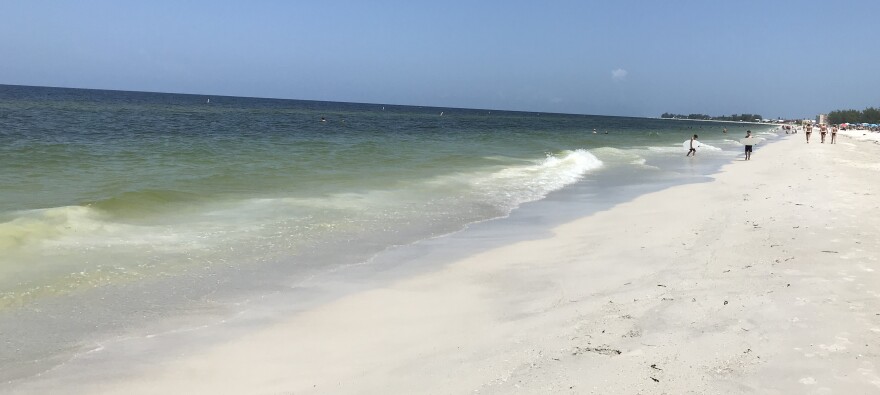A toxic red tide algae bloom that’s been persisting in Southwest Florida for nearly a year is now making its way to the Tampa Bay area. It’s been most recently reported as far north as Pinellas County.
This past weekend, beachgoers on Anna Maria Island in Manatee County witnessed thousands of dead fish and other marine life wash ashore from red tide poisoning.
On Wednesday, there wasn't really evidence of the massive fish kill that happened on Holmes Beach just a few days before, but there was a lingering odor of dead fish.
And there were clues on the beach: scattered fish bits left after seagulls picked the carcasses apart. And yet, tourists like Carl Bear still walked the shoreline. He was there when red tide hit this area, and saw it all.
"It looked like blood was rolling up on the waves. We saw dead fish-- thousands-- can't count 'em." He said. "It's just so bad, and eels, and all kinds of different size of fishes."
Bear is from Pennsylvania and has been vacationing here every summer for the last eight years.
"This is the first year we ever had any trouble down here," he said.

Bear and his family avoided red tide that day by traveling north to Pinellas County's Fort De Soto, but at a resort just about a mile south, they're finding not all visitors are willing to stick around.
Cory Huffman manages the Bungalow Beach Resort. She said in the past 20 years that she’s worked there, they’ve maybe only had a cancellation or two due to red tide.
"This year, it seems to be much worse where people from up north are hearing about it and we're getting cancellations every day," she said. "And even some folks are leaving early to escape it."
The red tide algae bloom isn't just making a mess on the beach, it's toxic. It can kill and sicken marine life in the water, and it can cause significant respiratory problems for people near it.
But Huffman is happy that the Manatee County officials are doing what they can to keep beaches clear of the dead fish.
Nick Azzara is the county spokesman. He said it's required a team effort, involving Manatee's property management, the county's parks department, and even inmates from the county jail are scooping fish into special "Fish Only" dumpsters placed throughout the island.

“The last time that I can remember a multi-agency coordinated effort like this was the 2010 BP oil spill,” said Azzara.
The county is responding to this like a public health emergency, but the cost of all this extra work hasn't been tallied yet.
“While cost is always a consideration in the things that we do, this is a huge top priority both for public safety and the local economy,” said Azzara.
For now, he said, the short-term plan is to remove dead fish from beaches as quickly as possible, which they haven't had to do since the first wave of dead fish arrived on Manatee beaches August 5. And when asked about the long-term, Azzara called red tide “the great unknown.”
But that’s not stopping Pennsylvania tourist Carl Bear and his family from continuing their tradition of visiting Anna Maria Island.
"We'll come back next year... the people are so great," said Bear.




